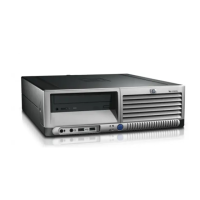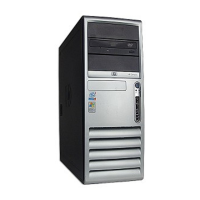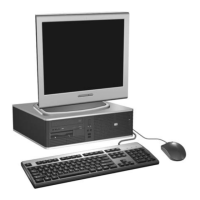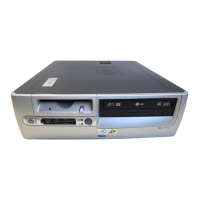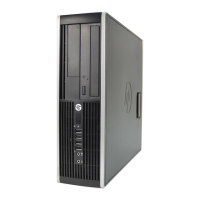Keyboards (not illustrated)
PS/2, Basic
USB, Basic
USB, Modular
355630-xxx
355631-xxx
355102-xxx
Arabic -175 German -045 Portuguese -135
Belgian -185
Greek -155 Russian -255
BHCSY -B45 Hebrew -BB5
Slovakian -235
Brazilian Portuguese -205
Hungarian -215 Spanish -075
Czech -225 International** -B35 Swedish*** -105
Danish -085 Italian -065 Swiss -115
Europe* -025 Japanese -295 Taiwanese -AB5
Finnish -355 Korean (Hanguel) -KD5 Thai -285
French -055 LA Spanish -165
Turkish -145
French Arabic -DE5 Norwegian -095 U.S. -005
French Canadian -125 PRC -AA5 U.K. -035
* For 355102 only
**Not for 355102
*** Not for 355630
USB Basic Keyboard (not illustrated)
Europe, gray and carbonite (Blue Angel) 355632-B35
System Board Connectors and Jumpers (position of some untitled components may vary in location)
CR1 5CV Aux power LED P24 USB connector, front panel
E14 Boot block P27 Multi Bay
E49 Password jumper P29 SCSI LED connector
J20 PCI slot 1
P52 Serial port “B”
J21 PCI slot 2 P54 Serial Port “A”
J31 PCI Express x1
P60 Primary Serial ATA (SATA) Port
J41 PCI Express x16
P61 Secondary Serial ATA (SATA) Port
P1 Main power (24 pin) P124 Hood lock
P3 Processor VccP Power 12V (6 pin) P125 Hood sensor
P5 Main power switch/LED SW50 CMOS button
P6 Internal chassis speaker XBT1 Battery
P7 CD audio in XMM1 Memory socket
P8 Primary chassis fan XMM2 Memory socket
P9 Secondary chassis fan XMM3 Memory socket
P10 Diskette drive XMM4 Memory socket
P11 Aux audio in XU1 Microprocessor
P20 IDE
XU100 Security
P23 Front audio
Riser Board Connectors
J9020 PCI connector J9021 PCI connector
System Hardware Interrupts
IRQ
System Function IRQ System Function
0
Timer Interrupt 8 Real-Time Clock
1
Keyboard 9 Unused
2
Interrupt Controller Cascade 10 Unused, available for PCI
3
Serial Port (COM B) 11 Unused, available for PCI
4
Serial Port (COM A) 12 Mouse
5
Unused, available for PCI 13 Coprocessor
6
Diskette Drive 14 Primary ATA (IDE) Controller
7
Parallel Port (LPT 1)
Computer Diagnostic LEDs (on front of computer)
LED Color LED/Beep Activity State/Message
Power Green On (S0) Computer on
Power Green 1 blink every 2 seconds (S1) Suspend Mode
Power Green 1 blink every 2 seconds (S3) Suspend to RAM
Power Clear Off (S4) Hibernation
Power Clear Off (S5) Computer off
Power Red* 2 blinks 1 second apart CPU thermal shutdown
Power Red* 3 blinks 1 second apart CPU not installed
Power Red* 4 blinks 1 second apart Power supply overload (crow bar)
Power Red* 5 blinks 1 second apart Defective or missing memory
Power Red* 6 blinks 1 second apart Defective or missing graphics
Power Red* 7 blinks 1 second apart System board failure (detected prior to video)
Power Red* 8 blinks 1 second apart Invalid ROM based on checksum
Power Red* 9 blinks 1 second apart System not fetching code
Power Red* 10 blinks 1 second apart System hang while loading an option ROM
Hard Drive Green Blinking Hard drive activity
*Blinking codes are repeated after a 2 second pause. Beeps stop after fifth iteration but LEDs continue until problem is
resolved.
Keyboard Diagnostic LEDs, PS/2 Keyboards Only
LED Color LED Activity State/Message
Num, Caps,
Scroll Lock
Green On (Rising Tone) ROM reflashed successfully
Num Lock Green On ROMPaq diskette not present, is bad, or drive
not ready.*
Caps Lock Green On Enter password.
Num, Caps,
Scroll Lock
Green Blink On in sequence, one at a
time - N, C, SL
Keyboard locked in network mode
* Insert valid ROMPaq diskette in drive A. Turn power switch off, then on to reflash ROM. If ROM flash is successful, all
three keyboard LEDs will light up, and you will hear a rising tone series of beeps. Remove diskette and turn power off,
then on to restart the computer. For more information about flashing the ROM, refer to the Troubleshooting guide.
Clearing CMOS
The computer's configuration (CMOS) may occasionally be corrupted. If it is, it is necessary to clear the CMOS
memory using switch SW50.
To clear and reset the configuration, perform the following procedure:
1. Prepare the computer for disassembly.
Ä
CAUTION: You must disconnect the power cord from the power source before pushing the Clear CMOS
Button (NOTE: All LEDs on the board should be OFF). Failure to do so may damage the system board
2. Remove the access panel.
3. Press the CMOS button located on the system board and keep it depressed for 5 seconds.
4. Replace the access panel.
5. Turn the computer on and run F10 Computer Setup (Setup utility) to reconfigure the system.
Disabling or Clearing the Power-On and Setup Passwords
1. Turn off the computer and any external devices, and disconnect the power cord from the power outlet.
2. Remove the access panel.
3. Locate the header and jumper labeled E49.
4. Remove the jumper from pins 1 and 2. Place the jumper over pin 2 only to avoid losing it.
5. Replace the access panel.
6. Plug in the computer and turn on power. Allow the operating system to start.
NOTE: Placing the jumper on pin 2 clears the current passwords and disables the password features.
7. To re-enable the password features, repeat steps 1-3, then replace the jumper on pins 1 and 2.
8. Repeat steps 5-6, then establish new passwords.
Refer to the Computer Setup (F10 Setup) instructions to establish new passwords.
Computer Setup (F10) Utility Features (features may vary)
File
System Information
About
Set Time and date
Replicated Setup
Default Setup
Apply Defaults and Exit
Ignore Changes and Exit
Save Changes and Exit
Storage
Device Configuration
Storage Options
DPS Self-Test
Boot Order
Security
Setup Password
Power-On Password
Password Options
Smart Cover
Embedded Security
Drivelock Security
Data Execution Prevention
Master Boot Record Security
Save Master Boot Record
Restore Master Boot Record
Device Security
Network Service Boot
System IDs
Power
OS Power Management Hardware Power Management Thermal
Advanced
Power-On Options
BIOS Power On
Onboard devices
PCI Devices
Bus Options
Device Options
PCI VGA Configuration
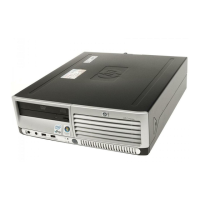
